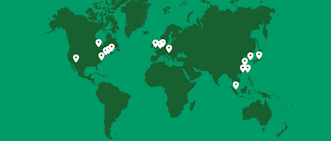
Release Date: 05/24/2021
May 25, 2021 (Boston, MA) -- Fortify, a Boston-based 3D printing startup, and Rogers Corporation, the global leader in engineered materials for advanced connectivity and power electronics, announced today their partnership to enable additive manufacturing of low-loss dielectric materials for radio frequency (RF) devices and electronics.
The partnership allows both companies to leverage their areas of expertise to unlock scalable manufacturing of high-value RF components. Rogers Corporation’s market dominance in low-loss, high frequency materials combined with Fortify’s advanced composite processing capabilities enables customers to efficiently design and print precision substrates, Luneberg-like Gradient Refractive Index lenses and end-use components. Fortify’s Continuous Kinetic Mixing (CKMTM) powered DLP platform enables high-throughput production of fine-featured parts out of heavily loaded materials that are otherwise difficult to process.
“As our world becomes increasingly connected, so does the need for faster and higher capacity wireless connections,” Trevor Polidore, New Product Development Group Leader at Rogers Corporation said. “Partnering with Fortify will allow Rogers to deliver a complete solution for the manufacturing of 3D-printed dielectric components, enabling our customers to create the next generation of wireless systems.”
Wireless communications and SATCOM systems have led the expansion of active antenna systems (AAS) use into mainstream consumer applications. By taking advantage of AAS’s ability to generate highly directive signals that can be electronically steered and form various beam patterns, the latest applications such as 5G and high-throughput satellites (HTS) can deliver services previously inaccessible with conventional antennas.
However, many AAS technologies are expensive and complex to manufacture with multitudes of performance tradeoffs that often require new technologies and high cost devices to yield competitive solutions. It is possible to address some of these challenges with intricate 3D dielectric materials, but complex 3D dielectrics have historically been difficult or impossible to manufacture with the necessary cost, quality and repeatability to meet practical manufacturing requirements.
“The photopolymers available today are an order of magnitude more lossy than thermoplastics, yet 3D printing complex parts at scale out of thermoplastics is time consuming.” Phil Lambert, Sr. Applications Engineer at Fortify said. “With the right low-loss material systems from Rogers combined with Fortify’s printers, we can offer a solution that provides excellent feature resolution, great RF properties and high throughput capabilities for end-use parts.
While traditional DLP platforms struggle to print highly viscous materials, CKM technology employed on all Fortify Flux Series printers allow for the processing of advanced materials, such as Rogers’ low loss materials, while maintaining material quality and consistency throughout the manufacturing process.
“With Rogers, we are positioned to commercialize the first scalable, low-loss 3D printed RF dielectric materials,” Josh Martin, CEO and Cofounder of Fortify said. “This partnership is a great example of how innovative materials and technology companies can come together and provide a differentiated value proposition to a rapidly growing market. Fortify has a scalable way of manufacturing continuously varying dielectric material, which is a game changer for the scanning beam antenna market (5G, surveillance, remote sensing and security)."
Applications of this new technology include passive lens devices that augment gain and directivity for single or multi feed systems found in RF sensing and SATCOM On-The-Move commlinks and 5G AAS systems to widen field of view and reduce sidelobe levels.
The advantages of Fortify's 3D printers for printed RF dielectric technology include: lower weight, wide bandwidth, scalable manufacturing, structure design freedom, quick turnaround parts and more. The two companies continue to collaborate to optimize printing processing parameters to realize all these benefits and more.
Fortify will be exhibiting at the upcoming International Microwave Symposium (IMS). Visit Booth #1451 to meet with Fortify and learn more.
About Fortify
Fortify is transforming the 3D printing industry with its patented DCM (Digital Composite Manufacturing) platform. DCM delivers new levels of additively manufactured part performance by introducing functional additives to photopolymers. By combining a deep understanding of material science with high performance mixing, magnetics, and polymer physics, Fortify is able to produce custom microstructures in high-resolution 3D printed parts. The company is currently focused on applications ranging from injection mold tooling to high performance end-use parts with unique mechanical and electromagnetic properties. Founded in 2016 and based in Boston, Fortify technology enables material properties and components unattainable using other additive or traditional manufacturing processes. For more information, visit www.3dfortify.com.
About Rogers Corporation
Rogers Corporation (NYSE:ROG) is a global leader in engineered materials to power, protect and connect our world. Rogers delivers innovative solutions to help our customers solve their toughest material challenges. Rogers’ advanced electronic and elastomeric materials are used in applications for EV/HEV, automotive safety and radar systems, mobile devices, renewable energy, wireless infrastructure, energy-efficient motor drives, industrial equipment and more. Headquartered in Chandler, Arizona, Rogers operates manufacturing facilities in the United States, Asia and Europe, with sales offices worldwide.
